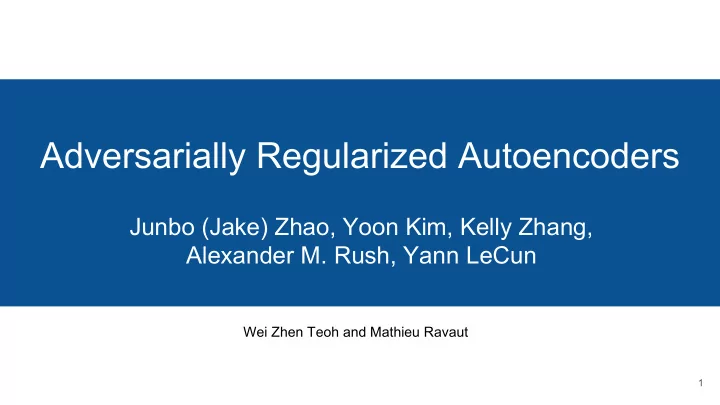

Adversarially Regularized Autoencoders Junbo (Jake) Zhao, Yoon Kim, Kelly Zhang, Alexander M. Rush, Yann LeCun Wei Zhen Teoh and Mathieu Ravaut 1
Refresh: Adversarial Autoencoder [From Adversarial Autoencoders by Makhzani et al 2015] 2
Some Changes - Learned Generator 3
Some Changes - Wasserstein GAN ● The distance measure between two distributions is defined by the Earth-mover distance, or Wasserstein-1: [From Wasserstein GAN by Arjovsky et al 2017] 4
Some Changes - Wasserstein GAN ● This is equivalent to the following supremum over Lipschitz-1 functions: ● In practice, f is approximated by a neural network f w where all the weights are clipped to lie in a compact space such as a hypercube of size epsilon. 5
Some Changes - Discrete Data Instead of a continuous vector, X is now discrete data: - Binarized MNIST - Text (sequences of one-hot vocabulary vector) [From https://ayearofai.com/lenny-2-autoencoders-and-word -embeddings-oh-my-576403b0113a] 6
Some Changes - Encoder (for sequential data) h n becomes the latent code c [From https://mlalgorithm.wordpress.com/2016/08/04/deep-learning-part-2-recurrent-neural-networks-rnn/] 7
Model 8
Training Objective Reconstruction loss Wasserstein distance between two distributions 9
Training Objective Components ● Reconstruction from decoder: ● Reconstruction loss: 10
Training Objective Components Discriminator maximizing objective: The max of this function approximates the Wasserstein distance Generator minimizing objective: 11
Training 12
Training 13
Training 14
Extension: Code Space Transfer Unaligned transfer for text: Can we change an attribute (e.g. sentiment) of the text without changing the content using this autoencoder? Example: 15
Extension: Code Space Transfer ● Extend decoder to condition on a transfer variable to learn sentiment attribute 16
Extension: Code Space Transfer ● Train the encoder adversarially against a classifier so that the code space is invariant to attribute Classifier: 17
Additional Training 18
Image model [From Adversarially Regularized Autoencoders by Zhao et al, 2017] AE: WGAN: EM distance Input images are binarized MNIST , but normal MNIST would work as well. 19
Text model [Partly from https://blog.statsbot.co/time-series-prediction-using-recurrent-neural-networks-lstms-807fa6ca7f] AE: ’ WGAN: EM distance Same generator architecture 20
Text transfer model AE: One decoder per class WGAN: EM distance Same generator architecture 21
Experiment #1 : effects of regularizing with WGAN Checkpoint 1 : How does the norm of c’ behave over training? [From Adversarially Regularized Autoencoders by Zhao et al, 2017] c’ L2 norm matching c L2 norm 22
Experiment #1 : effects of regularizing with WGAN Checkpoint 2 : How does the encoding space behave? Is it noisy? [From Adversarially Regularized Autoencoders by Zhao et al, 2017] c’ and c sum of dimension-wise variance matching over time 23
Experiment #1 : effects of regularizing with WGAN Checkpoint 3 : Choose one sentence, then 100 other sentences within an edit-distance inferior to 5 [From Adversarially Regularized Autoencoders by Zhao et al, 2017] Average cosine similarity in latent space. Maps similar input to nearby code. 24
Experiment #1 : effects of regularizing with WGAN Checkpoint 4 : Swap k words from an original sentence. [From Adversarially Regularized Autoencoders by Zhao et al, 2017] Left : reconstruction error (NLL). Right : reconstruction examples. 25
Experiment #2 : unaligned text transfer Decode positive sentences Decode negative sentences Encode all sentences [Partly from https://blog.statsbot.co/time-series-prediction-using-recurrent-neural-networks-lstms-807fa6ca7f] Remove sentiment information from the latent space: • At training time: adversarial training. • At test time: pass sentences of one class, decode with the decoder from the other class 26
Experiment #2 : unaligned text transfer Results: • Better transfer [From Adversarially Regularized Autoencoders by Zhao et al, 2017] • Better perplexity • Transferred text less similar to original text 27
Experiment #3 : semi-supervised classification SNLI dataset: o 570k human-written English sentence pairs o 3 classes: entailment, contradiction, neutral Medium: 22.% of labels Small: 10.8% of labels Tiny: 5.25% of labels [From Adversarially Regularized Autoencoders by Zhao et al, 2017] 28
Playground: latent space interpolation [From Adversarially Regularized Autoencoders by Zhao et al, 2017] 29
Conclusion about Adversarially Regularized AEs Pros : Cons : ✓ Better discrete ❖ Sensitive to hyperparameters autoencoder (GANs…) - Semi-supervision ❖ Unclear why W GAN - Text transfer ✓ Different approach to ❖ Not so much novelty text generation compared to Adversarial Auto Encoders (AAE) ✓ Robust latent space ❖ Discrete data but no discrete latent structure :/ 30
Recommend
More recommend